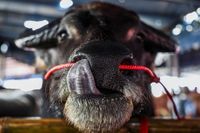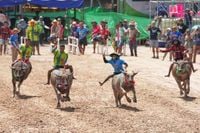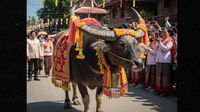On October 6, 2025, the city of Chonburi, Thailand, about an hour’s drive from Bangkok, came alive with the thunder of hooves, laughter, and the vibrant swirl of tradition as it hosted the 154th annual water buffalo festival. This was no ordinary gathering: it marked the end of the 11th lunar month, a time that once signaled the beginning of the harvest season, and now serves as a stage for the evolving role of the humble water buffalo in Thai society.
Once the backbone of Thai agriculture, water buffaloes—known locally as “kwai”—were prized for their strength, their ability to plough fields, and their patience in hauling heavy loads across rice paddies. But as tractors and mechanized farming tools rolled in, these gentle giants saw their numbers dwindle and their roles shift. Today, the festival is both a celebration and a rescue mission, putting the spotlight on animals that have moved from farmhands to cultural icons and, increasingly, show animals.
This year’s festival was a spectacle of color and energy from the very start. The event kicked off with a ceremonial parade featuring students performing traditional Thai dances. Buffaloes, some adorned with flower crowns, pulled wooden carriages with wheels towering at two meters high, carrying proud owners and women dressed in elegant traditional garb. The scene was a photographer’s dream, with families and children gathering to snap pictures with the largest and most striking animals.
But the real stars of the show were the buffaloes themselves. Among them was Tod, a five-year-old with a striking dark coat and bright red ear coloring, making his debut in the buffalo beauty contest. Owned by food vendor and farmer Thawatchai Daeng-Ngam, Tod was the center of attention. “Buffaloes are still important to me. It’s like what they said: ‘People raise buffaloes, and buffaloes raise people.’ It’s like a family member,” Thawatchai told the Associated Press. For Thawatchai, raising buffaloes is more than a livelihood—it’s a cherished hobby and a family tradition. His family still keeps 30 buffaloes, and he lets Tod roam freely on their farm, attending the festival to see how his prized animal would fare against the competition.
The festival’s events are as diverse as they are lively. There’s the much-anticipated buffalo beauty pageant, where animals are judged on horn size, hoof smoothness, and overall physique by judges donning bolo ties and cowboy hats. On larger farms, caretakers bathe the buffaloes daily and feed them a special diet of corn, soy, bran, and vitamins to ensure they’re in top form. As Kijchai Angkhanawin, a caretaker for prized buffaloes, explained to CNN, “They are judged on horn size, hoof smoothness and overall physique.”
Then come the races—heart-pounding sprints down a 100-meter track, with jockeys clinging to their buffaloes as they charge past grandstands and festival lighting. Pitun Rassamee, another devoted owner, entered the fray with his three-year-old albino buffalo named Lookaew, whose name means “Marble.” Having already won several local competitions, Lookaew was a crowd favorite. Hope ran high: in 2024, an albino buffalo was sold for a staggering 18 million baht (about $672,000) after winning multiple pageants, a testament to the rising value of these animals in the show circuit.
But it’s not all just fun and games. The festival serves a deeper purpose—preserving cultural heritage and supporting small farmers. As tractors have replaced buffaloes in the fields, many owners faced tough choices: either enter their animals in competitions or sell them for meat. Contests like Chonburi’s have injected new life into the industry, creating incentives for farmers to continue raising buffaloes and, in turn, preserving a vital part of Thailand’s rural identity.
Government support has played a crucial role in this transformation. Recognizing the decline in buffalo populations, the Thai government established Buffalo Conservation Day in 2017, celebrated on May 14 each year. Local authorities now provide breeding assistance and support to farmers, ensuring that the tradition of buffalo-raising doesn’t vanish in the face of modernization. “Each year it has become bigger and bigger,” said Papada Srisophon, assistant to the chief of a village near a livestock center where farmers learn techniques to raise the animals, as quoted by The Independent. “Without this activity, they won’t know what to do with their buffaloes, and they won’t be motivated to keep their buffaloes.”
The festival has also become a magnet for tourists and locals alike, growing in size and popularity with each passing year. Water trucks and even fire trucks supply water for the animals, while visitors flock to interactive exhibits, photo opportunities, and the main events. For many, it’s a chance to reconnect with roots, to witness a living tradition, and to marvel at the strength and beauty of animals that once ploughed their ancestors’ fields.
Yet, the festival isn’t without its risks. Buffalo racing is a thrilling, but sometimes hazardous, sport. In 2022, racer Noppadon Yindeesuk, then 45, reflected on the dangers: “It could be a bit dangerous if the buffalo are running too close to each other because it could cause an accident – so the riders must be careful,” he told AFP. Nevertheless, Yindeesuk continues to compete, driven by a desire to preserve Chonburi’s traditions of “good rice, good buffalo.”
For all the pageantry and excitement, the heart of the festival beats with a sense of continuity—of families, farmers, and entire communities coming together to honor their past while looking to the future. “Although buffaloes can still work in the field, they cannot compete with machines,” Thawatchai admitted. But the festival proves that, while their roles may have changed, buffaloes remain woven into the fabric of Thai life.
As the sun set over Chonburi and the last race was run, the message was clear: the water buffalo, once a simple draft animal, now stands as a symbol of resilience, heritage, and community. The festival is not just about crowning the fastest or the most beautiful buffalo—it’s about keeping alive a tradition that continues to raise people, just as people have always raised buffaloes.



